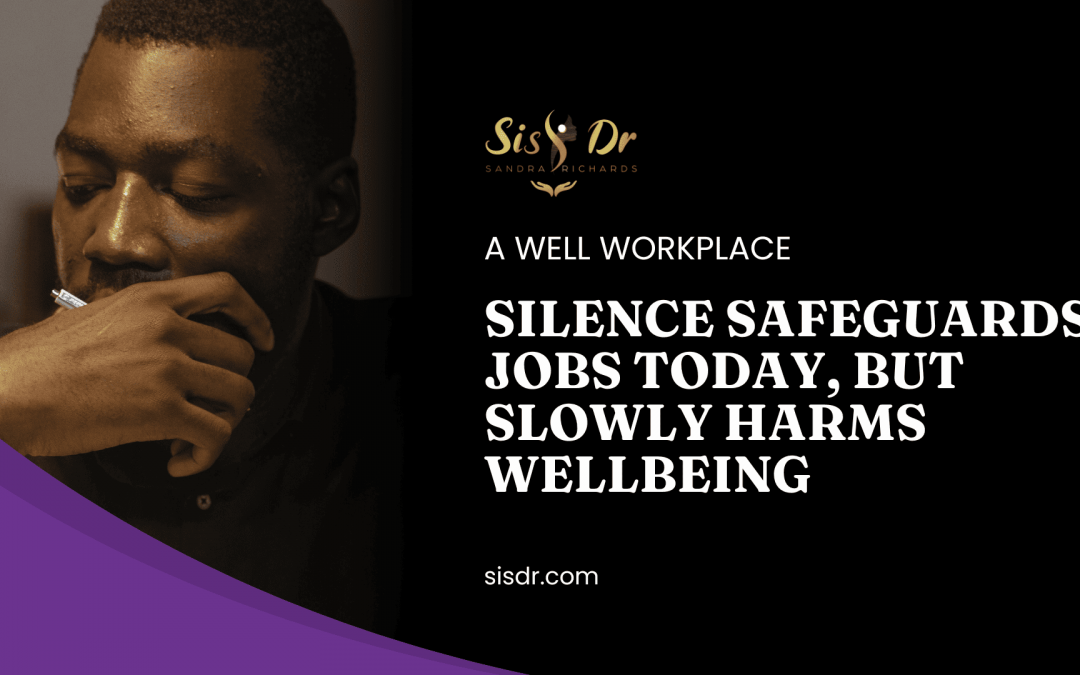In many workplaces, silence is not a sign of agreement or comfort. It is a strategy of survival. For staff from Black, Brown, and other culturally diverse backgrounds, silence often becomes the safest option when faced with bias, microaggressions, or exclusion. Speaking up can carry risks—being labelled as ‘difficult,’ losing opportunities for promotion, or facing subtle retaliation that undermines career progression.
While silence may protect careers in the short term, the long-term cost is steep. It creates a pattern of chronic stress, emotional disconnection, and disengagement that damages both the individual and the wider organisation.
The Wellbeing Impact of Silence
Remaining silent is rarely a neutral act. For diverse employees, the effort to absorb harm without response has clear psychological consequences:
- Chronic stress responses: Enduring bias or exclusion without acknowledgement forces the body into ongoing vigilance, with impacts on both mental and physical health.
- Disconnection from work: When staff feel their voice is unsafe, they gradually withdraw from active participation, reducing collaboration and creativity.
- Erosion of identity and confidence: Silence, over time, communicates that authenticity is a liability. This undermines confidence and self-worth, creating an emotional distance from colleagues and leadership
-
Silence protects the career path on paper, but it drains the wellbeing of the person travelling it. Eventually, the organisation itself pays the cost.
Why Organisations Should Pay Attention
Silence is not simply a personal coping mechanism. It is an organisational red flag. When staff choose silence, they are signalling a lack of psychological safety.
This impact includes:
- Reduced engagement: Teams miss out on contributions, insights, and innovations because staff do not feel safe to speak.
- Hidden attrition risks: Employees who remain quiet often become the first to leave, taking valuable knowledge and skills with them.
- Weakened trust: Staff cannot trust leaders who allow silence to be the safest option. This undermines both wellbeing programmes and leadership credibility.
-
Wellbeing cannot take root in an environment where staff feel compelled to protect themselves through silence. For organisations, the silence of diverse employees should never be misread as contentment.
What Organisations Can Do
Silence does not ease on its own. Leaders and organisations must create spaces, structures, and practices that make voices feel safe and respected. Change takes time, but these foundations are what allow both wellbeing and growth to take root in an organisation.
1) Opening Safe Pathways for Voice
Staff must have avenues to raise concerns outside their direct line manager. These systems should guarantee anonymity and protection from retaliation.
2) Hearing Silence as a Signal of Hurt
Managers should be taught to see silence not as compliance, but as a sign of potential harm. They must know how to invite contributions in ways that are respectful and culturally aware.
3) Standing With Those Who Speak Up
Speaking takes courage when careers feel at risk. Organisations show their integrity by protecting those who raise concerns, making it clear that retaliation will not be tolerated and that accountability rests with leadership.
4) Valuing Honesty with Compliance
Encourage and recognise employees who bring forward ideas or feedback, ensuring they are valued for their input, not penalised for honesty.
Building these commitments requires intention and persistence. Yet, the payoff is profound: reduced attrition, greater trust, and the creation of a culture where wellbeing and innovation are supported rather than silenced.
Wellbeing-Centred Culture
Breaking the cycle of silence is not only an act of fairness. It is essential to building cultures where wellbeing is possible. When organisations treat silence as a risk rather than a solution, they create conditions where staff can engage authentically without fear.
The question for leadership is not how to encourage staff to ‘speak up’ more loudly, but how to design workplaces where staff no longer feel that silence is their safest form of protection.
About SisDr
SisDr is a Cultural and Wellbeing Practitioner, Counsellor, and Educator with over 30 years’ experience supporting women, men, families, and organisations. Her work blends psychological knowledge with cultural guidance, empowering individuals on journeys of emotional healing, identity reclamation, and transformational change.

